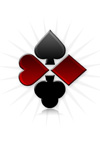 Poker, aggression is still regarded as one of the most powerful weapons in the arsenal of a player. Building, you can win the pot in two ways, either your opponent folds or your hand is the best. However, if you flop a monster, you do not want to sleep your opponent. You want to pay is not it?
Poker, aggression is still regarded as one of the most powerful weapons in the arsenal of a player. Building, you can win the pot in two ways, either your opponent folds or your hand is the best. However, if you flop a monster, you do not want to sleep your opponent. You want to pay is not it?Definition: The slowplay is a strategy in which you play a strong hand passively in order to later collect a larger profit.
Poker, aggression is still regarded as one of the most powerful weapons in the arsenal of a player. Building, you can win the pot in two ways, either your opponent folds or your hand is the best. However, if you flop a monster, you do not want to sleep your opponent. You want to pay is not it? Take a simple example: suppose you have 5![]() 5
5![]() and on the flop, there are 5
and on the flop, there are 5![]() K
K![]() K
K![]() . Your opponents check to you, it is your first thought?
. Your opponents check to you, it is your first thought?
Let us imagine in an ideal world. Your opponent has A![]() Q
Q![]() . You check. On the turn, 3
. You check. On the turn, 3![]() . It check and you check behind. River, 2
. It check and you check behind. River, 2![]() . Bingo! He hits his flush, put it, you raisez, reraise you, you push all-in and it you call! Congratulations, you have just doubled!
. Bingo! He hits his flush, put it, you raisez, reraise you, you push all-in and it you call! Congratulations, you have just doubled!
However, if you've thought about checker and go there for a first slowplay, I think you're wrong. I said earlier, the most powerful weapon of a poker player is his aggressiveness. Well, what do you read me? =) The slowplay must be a weapon in your arsenal available to vary your game. By vary his game, I mean once from time to time, not all the time you have a good hand. When your opponent realizes that you can slowplayer, it may stop to take your check as each time being showing signs of weakness. There are some dangers to the slowplay, however, every time you hit this probability, this is your stack in full which will spend.
Keeping the biggest danger to the end, the first drawback is that the pot grows not and that you are not able to largest profit made at the end of the hand. Returning to the example above, you have a full house and you put your opponent on K - J with blinds of $ 1 and a pot of $ 8. The check to you, in watch opponent also, you keep the pot at $ 8. Suppose you bet three-fourths of the pot every time after, on the turn, you send $ 6. The opponent you call you call and the pot becomes $ 20. River, you send $ 15 and the opponent call. You win (assuming you earn) a $ 50 pot.
Let's look at what happens if you wager this flop, it was $ 8, you send $ 6, Cabrera opponent monte the pot has $ 20. You send $ 15 to the turn and receive the call. The pot on the river is $ 50, you can therefore send a bigger value bet at the end! Following our logic, you send $ 37.50, the opponent is unable to fold its hand and follows you. You win a pot of $ 125. You double the size of the pot just by sending a small bet on the flop. The effect will be reduced by smaller updates, but the principle remains the same. Also note that you see the chance to check - raiser every time.
Another risk that you run in slowplayant, it's not to make you pay. Continue the same example again and you put your opponent on A![]() Q
Q![]() , you check and no Spades out on the turn. You continue your tactics and checker the turn, no bites on the river either. Now, instead of being a little paid for your hand, you won't be paid at all. By betting on the flop and the turn, you would have done paying your opponent for its circulation. You can even arrange to give favorable ratings to touch its flush, it is cooked in advance and doesn't even know!
, you check and no Spades out on the turn. You continue your tactics and checker the turn, no bites on the river either. Now, instead of being a little paid for your hand, you won't be paid at all. By betting on the flop and the turn, you would have done paying your opponent for its circulation. You can even arrange to give favorable ratings to touch its flush, it is cooked in advance and doesn't even know!
All the above mentioned risks were that the loss in value that you could pick, on the other hand, the greatest risk in slowplayant is to see your stack in the hands of your opponent. The most typical example of this consequence is when the big blind hits a pair well hidden against a player who had limp preflop with his ACE for trapping. This situation happens while you might win a small pot instead of losing a lot, because the other player has a hand that would not be followed, but it will be a pleasure to play with you once fight you! When the big blind is J - 2 and you limp with your ACE and as the flop is 2-7-J, you ran after. In our example, suppose that your opponent has 7![]() 7
7![]() . You check, turn: 7 d. That is, you are going to have the action you wanted, but not for the right reasons.
. You check, turn: 7 d. That is, you are going to have the action you wanted, but not for the right reasons.
You might start to believe that I am totally against this technique. Be aware that I am not against, I just wanted to warn that the next time that your Monster will be cracker because you've been too passive, you are the only person to blame. Reviews the elements in which you should not slowplayer:
-> When the board gives too many chances to the other. If you have 4![]() 5
5![]() on a flop of heart, you pray to not see another heart on the turn or the river (if you're not already beaten). A set of 5 on a 2-5-J may be a good idea if you know that your opponent can lose a lot on a high pair, hoping to see a lady, a King or an ACE on the turn (or even a J!), it is a better time to do so.
on a flop of heart, you pray to not see another heart on the turn or the river (if you're not already beaten). A set of 5 on a 2-5-J may be a good idea if you know that your opponent can lose a lot on a high pair, hoping to see a lady, a King or an ACE on the turn (or even a J!), it is a better time to do so.
-> If your opponent is a calling station, bet immediately, especially if he pays dearly for his prints. Enjoy!
-> If your opponent is passive, best bet in his place. It raisera you (or reraisera) not even if it affects what he wants.
What is the best time to slowplaye? When you have the best hand absolute on a board very dry in texture. If you have K![]() K
K![]() on a flop, K
on a flop, K![]() K
K![]() 2
2![]() rainbow, as possible slowplayez. You get no action person otherwise.
rainbow, as possible slowplayez. You get no action person otherwise.




